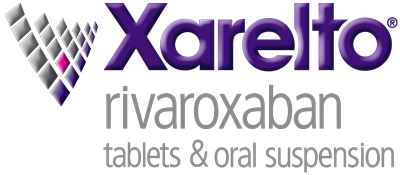Each day, people like you search online for answers to questions about atrial fibrillation (AFib) and XARELTO®. So we wanted to take this opportunity to answer some of them. Below, you’ll find answers to the questions people ask the most.
Atrial fibrillation (AFib) FAQs
When you have AFib, your stroke risk increases over time. XARELTO® is a prescription blood thinner that helps to reduce your stroke risk by helping to prevent blood clots from forming inside your heart. Read more about AFib and stroke.
AFib is a long-term condition that increases the risk of stroke, and your risk can increase over time. Only your healthcare professional can decide how long you should take XARELTO®. Do not stop taking XARELTO® without talking to the healthcare professional who prescribes it for you. Stopping XARELTO® increases your risk of having a stroke.
The CHA2DS2-VASc score is a measure of AFib-related stroke risk based on certain risk factors. It uses a scale of 0 through 9, with 0 being low risk and 9 being high risk. Learn more about the CHA2DS2-VASc and use our risk calculator to find your score.
No. You are at risk of stroke from AFib even if you don’t feel symptoms. Do not stop taking XARELTO® without talking to the healthcare professional who prescribes it for you. Stopping XARELTO® increases your risk of having a stroke. If you have to stop taking XARELTO®, your healthcare professional may prescribe another blood thinner to help prevent blood clots from forming.
To reduce your risk of an AFib-related stroke, you should take XARELTO® once a day with your evening meal. If you miss a dose of XARELTO®, take it as soon as you remember on the same day. Take your next dose at your regularly scheduled time.
Ask your healthcare professional about treatment options. The American Heart Association does not recommend aspirin as an option for the prevention of stroke due to AFib. In general, aspirin is considered to be inferior to other blood thinners for reducing stroke risk in people with nonvalvular AFib and a CHA2DS2-VASc score of 2 or higher. It’s also important to remember that the CHA2DS2-VASc score, which is a measurement of your stroke risk, can change over time. Your score may be low now, but if you have a score of 2 or higher, you may want to talk to your healthcare professional about managing your stroke risk with a blood thinner like XARELTO®.
XARELTO® FAQs
XARELTO® is a prescription blood thinner that reduces the risk of stroke in people with nonvalvular atrial fibrillation (AFib). Learn more.
XARELTO® lowers your blood’s ability to clot by selectively blocking one of the clotting factors found in your blood—an enzyme called Factor Xa (“10a”). Learn more.
It has been shown that the effect of XARELTO® on your body’s blood-clotting function is the same regardless of age, race, weight, sex, or dietary changes. There are also limited known interactions between XARELTO® and other medications.
If you take XARELTO®, regular blood tests are not needed to see if XARELTO® is working, to check your blood-thinning levels (international normalized ratio, or INR), or to change your medication dose.*
*Certain patients with impaired kidney function may be monitored by their healthcare professional and have their dose adjusted as necessary.
XARELTO® has fewer drug interactions than older medicines like warfarin. Not only does warfarin interact with other medicines, alcohol, and certain foods (especially those high in vitamin K, like leafy greens), but the initial dosing of warfarin varies widely from person to person based on a number of factors, including age, race, weight, and sex. Because of this, when taking warfarin, you will need to have regular blood tests—in some cases as often as 1 or 2 times a week—to ensure your warfarin dose remains safe and effective.
You should always tell your healthcare professional about all the medicines you take, including prescription and nonprescription medicines, vitamins, and herbal supplements—especially if you take ketoconazole, ritonavir, erythromycin, carbamazepine, phenytoin, rifampin, or St. John’s wort.
Unlike warfarin (Coumadin®), XARELTO® has no known dietary restrictions. You do not have to adjust your intake of leafy greens and other foods high in vitamin K, as they don't affect how XARELTO® works.
Under the supervision of your healthcare professional, like other prescription medicines, XARELTO® may be taken with other medications. Always tell your healthcare professional about all the medicines you take, including prescription and over-the-counter medicines, vitamins, and herbal supplements—especially if you take ketoconazole, ritonavir, carbamazepine, phenytoin, rifampin, erythromycin, or St. John’s wort.
It’s also important to note that, as with all blood thinners, you have a higher risk of bleeding if you take XARELTO® with other medicines that also increase your risk of bleeding, such as aspirin, non-steroidal anti-inflammatory drugs (NSAIDs), warfarin, any medicine that contains heparin, clopidogrel (Plavix®), selective serotonin reuptake inhibitors (SSRIs) or serotonin norepinephrine reuptake inhibitors (SNRIs), or other medicines to prevent or treat blood clots.
Like all blood thinners, XARELTO® can cause bleeding, which can be serious, and in rare cases, can be life threatening. Be sure to take XARELTO® exactly as prescribed, and do not stop taking XARELTO® without talking to the healthcare professional who prescribes it for you. You should discuss all potential benefits and risks with your healthcare professional.
When starting XARELTO®, it takes 2–4 hours for it to reach its full blood-thinning effect, and it leaves your system more quickly than warfarin—typically in about 24 hours. Compared to warfarin, which can take 3–4 days to reach its full blood-thinning effect and up to 7 days to leave your system, XARELTO® may be an option for people who plan to have surgery or surgical dental procedures.
XARELTO® was developed together by Janssen and Bayer. They continue to develop XARELTO® to treat and help reduce the risk of blood clot–related events in different conditions.
